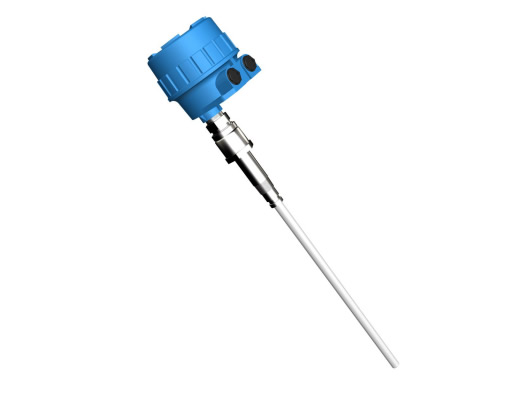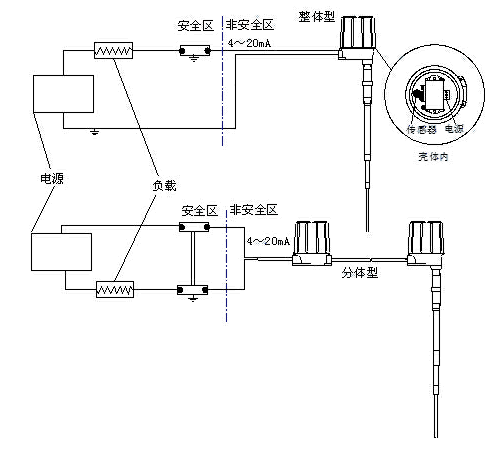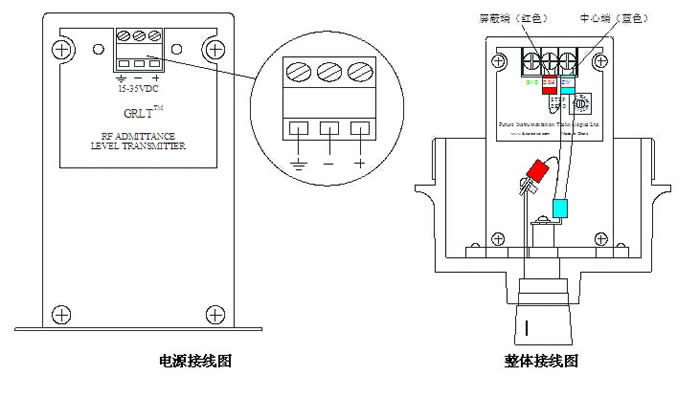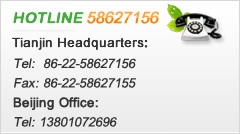FT8051 series RF Admittance Continuous Level Syste

FT8051 serial RF admittance Continuous Level System 》》》》
FT8051 Series is a general-purpose RF admittance level system, used for most continuous level measurements. It is comprised of one electronic unit, one connecting coaxial cable and one rigid or cable sensing element (or probe). These components can be connected in an integral configuration or a remote configuration where all electrical components are mounted away from the measuring point The sensing element can be manufactured of many different metals and insulators depending on the specific application.
》》》》Operation Principle
As stems from capacitance level control technology, the Radio frequency admittance technology is a more advanced level control technology with a better coating rejection ability (material adhere on the sensing element is called as coating)、more reliable operation、higher accuracy、wider application. “Admittance” in Radio Frequency Admittance means the reciprocal of impedance. Under basic electrical theory, it is comprised of the value of resistance, capacitance & inductance. While “Radio frequency” means high frequency radio wave, so the radio frequency admittance could be understand as a method to measure admittance through high frequency radio wave. High frequency sine-wave oscillator sends a stable detect signal to accurate measure the admittance value of the sensing element (installed on the process vessel) through the capacitance bridge, under direct working mode, the instrument output will increase along with the level arise.
The main differences between the “Radio Frequency ” technology and simple capacitance technology are different measuring variables、three-terminal driven-shield technology and the addition two important circuits, those are progressive improvement base on long time industry experiences. The above techniques not only resolve the connecting cable interference and temperature drifting, but also eliminate the process material coating on the sensing element tip under integral installation condition. The two important circuits are: High accurate oscillator buffer and alternating transition chopper driver.
For a vessel with strong conductive material inside, since the process material is conductive, so the ground could be seen as on the surface of the sensing element insulating layer, for sensing element, it is a pure capacitance. Along with the vessel layout, there will has some coating on the sensing element rod, the coating has impedance, as a result, the previous pure capacitance become a
complex impedance which comprise of capacitance and resistance. This will cause two problems.
The first problem is the impedance of the coating in probe equivalent circuit will pull the oscillator down, change the bridge output, cause measuring error(pure capacitance does not consume energy as process material to be seen as capacitance to probe). We overcome this problem by integrating a special buffer amplifier between the oscillator and bridge to compensate for current flow in the probe circuit. This assures that the oscillator voltage is stable and the signal on the probe is stable.
The second problem for conductive material measurement is the build-up left on the sensing element when the Level goes down. The build-up contains both capacitance and resistance and is connected to ground through the actual level on the probe. The build-up is seen by the measuring circuit as level. If the material is very conductive the whole coating will be read as level Sketches and equivalent circuit and the more conductive the material is, the more error will occur.
But there is no material is totally conductive. From electricity theory, coating could be seen as a resistor, the build-up on the sensing element could be seen as a transmit wire which made up by an infinite number of small resistances and capacitances, and the coating impedance of capacitance & resistance is the same value if the build-up is long according to mathematical theory. So we use the alternating transition chopper driver to measure the capacitance and resistance parts of the coating separately, then the total measured capacitance is Clevel+Ccoating ,minus the same resistance value as Ccoating,we obtain the real level value with virtually no coating error. E.g.
Cmeasure =Clevel + Ccocating
Clevel =C measure - Ccoating
=Cmeasure - R
Base on different variable measurement, through driven shield technology for the cable and adopt the special buffer and chopper circuits, the three improvements give RF Admittance technology a unique vitality in most industry applications.
》》》》Character
Ø Intrinsic safe design: two wire intrinsic safe design both for electronic unit and sensing
element
Ø Free maintenance: No period maintain or replacement needed as other paddle、vibration
or mechanical switches, the parts will not occur block、broken or abrasion.
Ø Coating rejection: Driven-shield electronic design makes the instrument ignore the coating
affection on the vessel wall or sensing element, no period clean or re-calibration needed.
Ø Chemical compatible: Variable sensing element design could meets any process material
requirements.
Ø Wide application: process temperature could run from -183℃~815℃, process pressure
could be vacuum~100bar.
Ø No drifting: will not drift along with the process temperature or density change
Ø Reliable Service life: unique technology give the instrument over 15 years service period
Ø Safety Protection: Built-in sensing element input protection avoid the instrument destroyed
under static energy/surge or electronic-chemical condition.
Ø Easy installation: instrument could be mounted in the field through the vessel screw or flange,
could be selected as integral or remote configuration, easy for installation and calibration
》》》》Typical Applications
Ø Liquid:conductive and insulating liquid(include liquefied gas)
Ø Slurry:conductive and insulating slurry
Ø Granular:food、plastic chips、coal etc
Ø Interface:liquid interface between two different dielectric constants
Ø Powder:plastic powder、cement or fly ash etc.
》》》》Specifications
Ø Measuring rate of facility: CAT I, transient over voltage 1500V, only use the equipment for measurements within measurement category I
Ø Output: 4~20mA
Ø Measuring Type:Level(DIR) or Distance(REV) field adjustable
Ø Power requirement:15~35VDC
Ø Dissipation power: less than 0.5W
Ø Accuracy: 1% FS
Ø Temp. Effect: 0.2% / 10℃(18℉)
Ø Load Resistance: 24VDC output loop resistance 450Ω
Ø Ambient Temp.:T5:-40~+70℃(-40~158℉);T6:-40~+60℃(-40~140℉)
(Effect of the process temperature on the environment temperature should not exceed the
environment temperature requirements of the instrument.)
Ø Response Time: <0.5second
Ø Time Delay: 0.5~80seconds adjustable
Ø Spark protection (for sensing element): anti-surge strike 1KV, anti-static 4KV/8KV
Ø Radio protection(Built-in filter):instrument pass through 10V/m space electromagnetic field and
3V/m electromagnetic field current injection tests
Ø Range: 20,000PF (Max.), max. length 1000m(39370”)(different probe has different range)
Ø Cable length:5m(197″)(standard),0.1(3.9″)~50m(1968.5″)(optional),
>50m(1968.5″)~ 100m(3937″)(consult factory)
Ø Electrical connection:double M20×1.5 (3/4” NPT optional )
Ø Process connection:NPT Thread(standard, BSPT optional) , Flanges (optional)
Ø Housing Material: Die casting aluminum epoxy coating
Ø Ingress protection:IP67
Ø Explosion-proof rating:Exia IIC T5/T6 Ga
Ø Approval:PCEC/NEPSI, for other approval please consult factory
》》》》Probe(sensing element) Specifications
|
No. |
Probe Insertion Length(IL) |
DSH |
Wetted Material |
Insulation |
S.E. Mounting |
S.E. Type |
Weight/ anchor |
Temperature/Pressure |
Application |
|
78 |
S.t.500mm(19.7")/250mm(9.8”) Max. 2m(78.7") |
250mm(9.8")/80mm(3.1”) 450mm(18”)/650mm(26”) |
304SS(s.t.) Other optional |
PPS |
3/4"BSPT |
O.D. 9mm(0.35") |
NO |
230℃/1.0MPa (446℉/145psi) 120℃/1.6MPa (248℉/232psi) |
Mid-Temperature Low pressure |
|
82 |
S.t.500mm(19.7") Max.5m(197") Rod |
250mm(9.8") Other optional |
304SS( s.t.) |
Ceramic |
1 1/4"BSPT |
O.D. 9mm(0.35") Three terminal |
NO |
815℃/0.1MPa (1500℉/15psi) 300℃/2.5MPa (572℉/363psi) |
High temperature |
|
82A |
S.t.500mm(19.7") Max. 25m(984") Cable |
250mm(9.8") Other optional |
304SS( s.t.) |
Ceramic |
1 1/4"BSPT |
O.D. 4mm(0.16”) Three terminal |
NO |
815℃/0.1MPa (1500℉/15psi) 300℃/2.5MPa (572℉/363psi) |
High temperature Long range |
|
82B |
S.t.500mm(19.7") Max. 5m(197") Rod |
250mm(9.8") |
304SS( s.t.) |
Ceramic |
1 1/4"BSPT |
O.D. 9mm(0.35") Three terminal |
NO |
815℃/0.1MPa (1500℉/15psi) 300℃/16MPa (572℉/2320psi) |
High-temperature High-pressure |
|
82C |
S.t.500mm(19.7") Max.5m(197") Rod |
250mm(9.8") Other optional |
316L( s.t.) |
Ceramic |
1 1/4"BSPT |
O.D. 9mm(0.35") Three terminal |
NO |
815℃/0.1MPa (1500℉/15psi) 300℃/10MPa (572℉/1450psi) |
High-temperature Corrosion |
|
84 |
Max. 3m(118") |
0mm(0") |
304SS( s.t.) |
PTFE/FEP |
3/4"BSPT |
O.D.12mm(0.47") Two terminal Rod |
NO |
150℃/4.0MPa (302℉/580psi) 40℃/6.3MPa(104℉/913psi) |
Short range Corrosive liquid |
|
85 |
Max.30m(1181") |
0mm(0") |
304SS( s.t.) |
PVDF |
1"BSPT |
O.D. 8mm(0.31") Two terminal Cable |
YES |
120℃/4.0MPa (248℉/580psi) 40℃/6.3MPa(104℉/913psi) |
Long range liquid, powder |
|
85A |
Max. 30m(1181") |
0mm(0") |
304SS( s.t.) |
PVDF |
1"BSPT |
O.D.12mm(0.47") Two terminal Cable |
YES |
120℃/4.0MPa (248℉/580psi) 40℃/6.3MPa(104℉/913psi) |
Long range liquid, powder heavy duty |
|
86 |
Max.22m(866") |
0mm(0") |
304SS( s.t.) |
PTFE |
1"BSPT 1"NPT |
O.D. 4mm(0.16") Two terminal Cable |
YES |
230℃/2.5MPa (446℉/363psi) 40℃/4.0MPa(104℉/580psi) |
Solid/powder Long range |
|
86A |
Max. 22m(866") |
0mm(0") |
304SS( s.t.) |
PTFE |
1"BSPT 1"NPT |
O.D. 8mm(0.31") Two terminal Cable |
YES |
230℃/2.5MPa (446℉/363psi) 40℃/4.0MPa(104℉/580psi) |
Solid/powder Long range heavy duty |
|
87 |
Max. 20m(787") |
80mm(3.1") Other optional |
304SS( s.t.) |
FEP |
3/4"BSPT |
O.D. 2.4mm(0.094") Two terminal Cable |
YES |
150℃/4.0MPa (302℉/580psi) 40℃/6.3MPa(104℉/913psi) |
Interface/liquid Long range |
|
89 |
Max. 1000m(39370") |
0mm(0") Other optional |
304SS( s.t.) |
PVDF |
3/4"BSPT |
O.D. 5mm(0.2") Three terminal Cable |
YES |
120℃/4.0MPa (248℉/580psi) 40℃/6.3MPa(104℉/913psi) |
Long range liquid Interface |
|
90 |
Max. 5m(197") |
0mm(0") |
304SS( s.t.) |
PTFE |
1 1/2"BSPT |
O.D. 38mm(1.5") Center shield ground Two terminal rod |
NO |
230℃/2.5MPa (446℉/363psi) 40℃/6.3MPa(104℉/913psi) |
Insulating liquid |
|
91 |
Max. 4m(157") |
0mm(0") |
304SS( s.t.) |
FEP |
DN80PN16 |
Twin probe total covered Two terminal rod |
NO |
150℃/4.0MPa (302℉/580psi) 40℃/6.3MPa (104℉/913psi) |
Short range Corrosive liquid |
|
92 |
Std. 500mm(19.7") Max. 2m(78.7") |
250mm(9.8") Other optional |
304SS(s.t.) Monel optional |
PTFE |
3/4"BSPT |
O.D.9mm(0.35") Three terminal Rod |
NO |
230℃/4.0MPa (446℉/580 psi) 40℃/6.3MPa (104℉/913psi) |
Insulating liquid |
|
93 |
Max. 3m(118") |
0mm(0") |
304SS( s.t.) |
PTFE |
1 1/2"Tri-clamp Other optional |
O.D. 12mm(0.47") Two terminal Rod |
NO |
230℃/2.5MPa (446℉/363psi) 40℃/6.3MPa(104℉/913psi) |
Sanitary 3A probe |
|
95 |
Max. 5m(197") |
0mm(0") Other optional |
304SS( s.t.) |
PTFE |
1"BSPT 1"NPT |
O.D.18mm(0.71") Two terminal Rod |
NO |
230℃/4.0MPa (446℉/580psi) 40℃/6.3MPa (104℉/913psi) |
Mid temp./press. Interface, desalter |
NOTE: 1. For agitation conditions, recommend to use bracket (rigid probe) or anchor (cable probe) for support. 2. DSH (shield length) must go into the vessel wall at least over 50mm. 3. For solid applications, the maximum length to go into cone should not bigger than 20% of the vessel O.D. 4. The maximum active range of FS89 is 400m. 5. For FS84 PTFE material, temp./pressure could reach 230℃/2.5MPa。6. For following applications, cooling extension is needed: 1) FS95 under or above 180℃/4.0MPa applications; 2) FS82 under or above 400℃ applications.
》》》》FT8051 Wiring
The FT8051 continuous system is an intrinsic safety system in both the integral or remote style when powered from an approved source with an approved barrier in series. Any single, double, repeater or loop barrier meeting the following conditions and approved by the appropriate agency should be adopted when the instrument installed in the hazardous area. Refer to Figure 4.1 System Wiring which is single barrier under integral installation & double barriers under remote installation. Please consult factory or the local representative to confirm which barrier to use. The total resistance of cable, load resistor and barrier should be 450 ohms under 24VDC power.
For ground wiring requirements of the barrier please refer to its manuals. The instrument requirement
to the barrier is:
Uo=28VDC
Io=93mA
Po=0.65W
Co=0.083uF
Lo=4.2mH
Instrument safety parameters are:
Ui=30V
Ii=100mA
Pi=0.75W
Ci=6nF
Li=240uH



》》》》FT8051 Installation Requirements
l Installation、Utility & Maintenance of the instrument should comply with the instruction manual and
GB50257《Construction & Verification Standard of Electrical apparatus mounting in explosion or flaming dangerous area》、GB3836.15 & GB3836.13 requirements.
l The mounting location of the instrument should free of vibration, high temperature, corrosive atmospheres, or any possibility of mechanical damage for maximum service life. If this is not possible, consider a remote system installation. Ambient temperature should be between -40 ~70oC (-40 ~158oF ).
l Instruments installed outdoors in areas of lightning strikes should be installed with lightning protection.
l DO NOT ADOPT MONO-COMPOSITION ENCAPSULAION SEALING inside of instrument housing since most of that kind of encapsulation will contain acetic acid. (Acetic acid could decay the electrical component.) Please consider to use SPECIAL DOUBLE-COMPOSITION ENCAPSULATION (non-erosive).
l The instrument has ground terminal on its housing. Please connect the terminals to the field ground properly during installation. For non-metallic vessel/tank installation, the filed should provide a standard ground. CONNECT TO DYNAMIC GROUND IS FORBIDDEN!
l Cable inlet should meet GB4208 standard requirements reach IP65 code to ensure reliable electrical connections. It will avoid water or other corrosive gas destroys the electronic unit.
l Do not open sensing element or loosen sealed gland. That may cause system leakage.
l Do not install the sensing element directly under a flow stream or feed line. If this is the only position available, use a baffle or shield above the probe to keep it out of the flow stream.
l Only the mounting screw or flange part of the sensing element need be well connected to the vessel, reliable sealed and electrical connected properly. Any other parts of the sensing element should not touch the vessel for good insulation.
l For horizontal mounting, sensing element should be pointed downward to the vessel, angle around 10~20o.
l Review the installation distance when mounting rigid probe. Keep the rigid probe at least 100mm away from the vessel wall. For cable probe, keep it as straight as possible and at least 300mm away from the vessel wall to avoid hitting the vessel wall (shorted to earth.).
l For agitation、gas/material flow fluctuation vessel, except avoid directly mechanical damage on sensing element, middle support (for rigid probe)/bottom anchor (for cable probe) of sensing element need be considered to avoid indirect mechanical broken under long-term utility. Please note: the support/anchor must be insulated with the sensing element. The insulating material should be high insulation, low hardness, lubricant and anti-abrasion material such as PTFE etc. Otherwise, periodical maintenance need be considered to avoid linkage loss.
l Probe is not allowed to go into cone part of the vessel under long range granular/powder application, since the pulling force of the material will increase tremendously at cone part. If necessary, the maximum length to go into cone should not bigger than 20% of the vessel O.D.
l The inactive part of the sensing element should go into vessel at least 50mm. For cable probe, the rigid part should not less than 200mm under horizontal mounting, 100mm for vertical mounting.
l For intrinsic-safe instrument installation, the loop should come with approved barrier according to GB3836.1 & GB3836.2 explosion-proof standard requirements.
l 24VDC Instrument power noise should be lower than 100mV.
l Power wire should meet IEC60245/60227 standard requirements Recommended as 3 terminal armature cable, cable O.D. should less than 12mm, conductor material of the cable is copper, section area should between 0.13 –2.1 mm2(AWG14-26), insulating capability 1500V. And associated switch should meet IEC60947 requirements. Do not make the unshielded cable parallel with power supply cable for long distance.
l Strict follow “STOP OEPN THE LID WHILE POWER ON” during field operation or maintain, recommend
to operate 10 minutes after power off.





 Products
Products